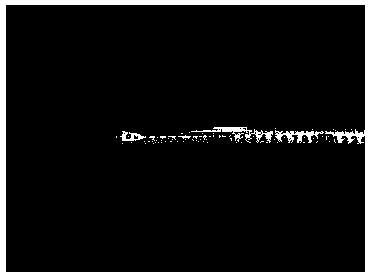Process for forming medium-strength heat-resistant magnesium alloy thick plate
A forming process, magnesium alloy technology, applied in the field of magnesium alloy deformation processing, forging and extrusion deformation of Mg-Al-Ag alloys, can solve the problem of not obvious effects of grain refinement and performance improvement, not deep deformation, etc. problems, to achieve the effects of small component segregation, high production efficiency and high surface quality
- Summary
- Abstract
- Description
- Claims
- Application Information
AI Technical Summary
Problems solved by technology
Method used
Image
Examples
Embodiment 1
[0016] Example 1: A smelting furnace with a capacity of 1 ton is used to melt the raw materials, semi-continuously casting and machining a Mg-8.0Al-0.5Ag-0.4Zn-0.1Mn-0.1RE-0.01Ca (wt.%) alloy ingot with a diameter of Ф300mm. Heat the ingot at 410°C for 5 hours, carry out upsetting multi-directional forging on the ingot on the hydraulic press, the reduction speed is 200-400mm / min, the reduction of the upsetting pass is 30-40%, and the reduction of the elongation pass is 5 -10%, upper and lower cutting board temperature 150-200 ℃. During the forging process, when the surface temperature of the billet is lower than 350°C, return to the furnace for annealing, the annealing temperature is 400°C, and the holding time is 3 hours. After annealing, repeat the upsetting and drawing process, and after three times of upsetting and drawing, the ingot pier is thickened to a diameter of Ф400mm. Heat the mold and extrusion barrel to a temperature of 200-300°C, keep the billet at 350°C for ...
Embodiment 2
[0017] Example 2: A smelting furnace with a capacity of 1 ton was used to melt the raw materials, semi-continuously cast and machined a Mg-8.5Al-0.8Ag-0.4Zn-0.1Mn-0.1RE-0.005Ca (wt.%) magnesium alloy billet with a diameter of Ф260mm. Heat the ingot at 400°C for 3 hours, carry out upsetting multi-directional forging on the ingot on the hydraulic press, the reduction speed is 200-400mm / min, the reduction of the upsetting pass is 30-40%, and the reduction of the elongation pass is 5 -10%, upper and lower cutting board temperature 150-200 ℃. During the forging process, when the surface temperature of the billet is lower than 350°C, return to the furnace for annealing, the annealing temperature is 380°C, and the holding time is 1.5h. After annealing, the upsetting process is repeated, and the ingot pier is thickened to a diameter of Ф380mm after four times of upsetting. Heat the mold and extrusion barrel to a temperature of 200-300°C, keep the billet at 340°C for 3 hours, and ex...
Embodiment 3
[0018] Example 3: Using a smelting furnace with a capacity of 1 ton to melt raw materials, semi-continuous casting and machining a Mg-9.0Al-0.6Ag-0.4Zn-0.1Mn-0.1RE-0.02Ca (wt.%) magnesium alloy ingot with a diameter of Ф300mm. Heat the ingot at 410°C for 5 hours, carry out upsetting multi-directional forging on the ingot on the hydraulic press, the reduction speed is 200-400mm / min, the reduction of the upsetting pass is 30-40%, and the reduction of the elongation pass is 5 -10%, upper and lower cutting board temperature 150-200 ℃. During the forging process, when the surface temperature of the ingot is lower than 350°C, return to the furnace for annealing, the annealing temperature is 400°C, and hold for 2 hours. After annealing, repeat the upsetting and drawing process, and after three times of upsetting and drawing, the ingot pier is thickened to a diameter of Ф400mm. Heat the mold and extrusion barrel to a temperature of 200-300°C, keep the billet at 340°C for 3 hours, a...
PUM
 Login to View More
Login to View More Abstract
Description
Claims
Application Information
 Login to View More
Login to View More - R&D
- Intellectual Property
- Life Sciences
- Materials
- Tech Scout
- Unparalleled Data Quality
- Higher Quality Content
- 60% Fewer Hallucinations
Browse by: Latest US Patents, China's latest patents, Technical Efficacy Thesaurus, Application Domain, Technology Topic, Popular Technical Reports.
© 2025 PatSnap. All rights reserved.Legal|Privacy policy|Modern Slavery Act Transparency Statement|Sitemap|About US| Contact US: help@patsnap.com

